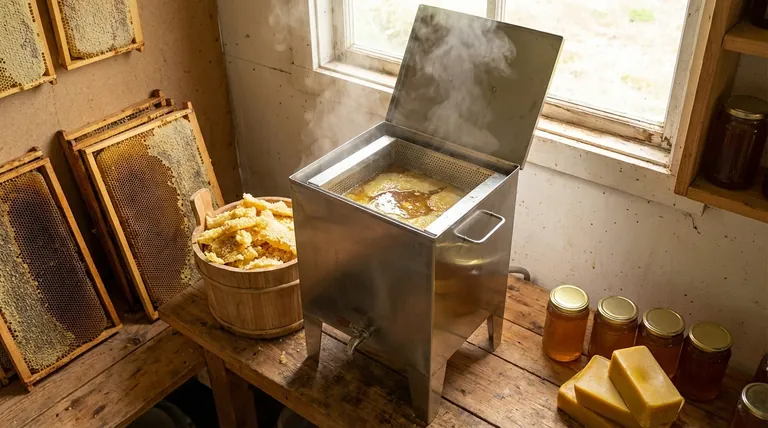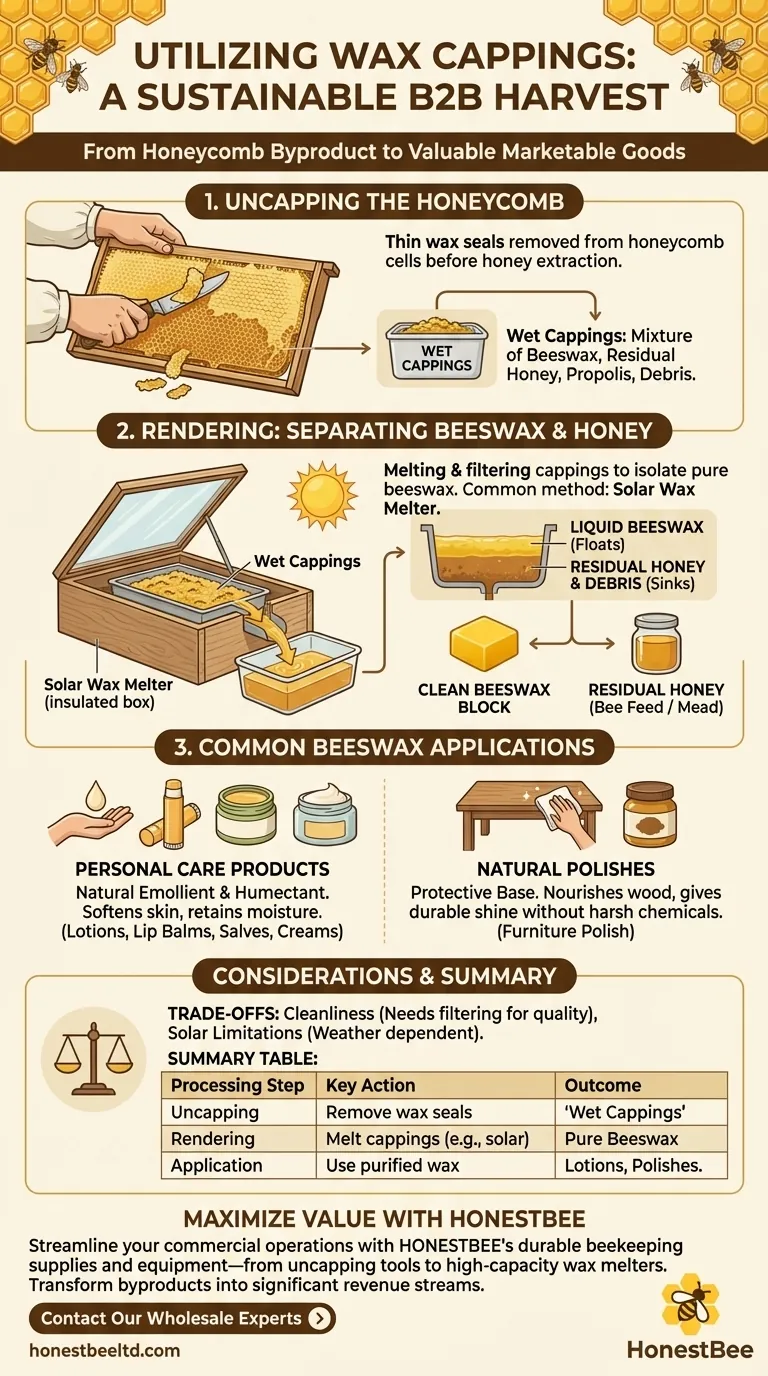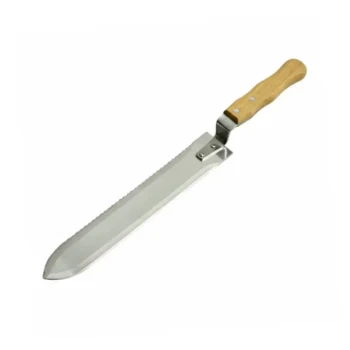To put it simply, the wax cappings removed from honeycomb frames are melted down to separate the pure beeswax from residual honey. This rendered beeswax is a valuable byproduct, most commonly used to create natural products like lotions and furniture polish.
The core principle is one of sustainable, no-waste beekeeping. Wax cappings are not a discard item but a secondary harvest that transforms a raw byproduct into valuable, marketable goods.

The First Step: Uncapping the Honeycomb
Before honey can be extracted, beekeepers must first remove the thin layer of beeswax that honey bees build to seal each cell of honeycomb. This protective layer is known as the "capping."
What Are "Wet" Cappings?
The removed cappings are a mixture of pure beeswax, a significant amount of residual honey that clings to the wax, and sometimes traces of propolis. This mixture is often referred to as "wet cappings."
The Goal of Processing
The primary goal of processing these cappings is to cleanly separate the valuable beeswax from the honey and any other hive debris.
Rendering Cappings into Pure Beeswax
Rendering is the process of melting and filtering the cappings to isolate the pure beeswax. This makes the wax clean, stable, and ready for use in other products.
Using a Solar Wax Melter
A common and energy-efficient method for this task is the solar wax melter. This is typically an insulated box with a dark interior and a glass or transparent lid.
The cappings are placed inside, and the heat from the sun gently melts the wax and honey.
How Separation Occurs
As the cappings melt, the basic principles of density take over. The heavier honey and debris sink to the bottom of the collector, while the lighter, liquid beeswax floats on top.
Once it cools, the wax solidifies into a clean, solid block that can be easily lifted off, leaving the residual honey behind.
Common Applications for Rendered Beeswax
Once the beeswax is rendered into clean blocks, it becomes a versatile and sought-after natural material for a variety of craft and commercial uses.
Crafting Personal Care Products
Beeswax is a prized ingredient in cosmetics and personal care. It is a natural emollient and humectant, meaning it softens skin and helps it retain moisture.
Common products include lotions, lip balms, salves, and creams.
Creating Natural Polishes
The protective properties of beeswax make it an excellent base for natural furniture polish. When mixed with oils, it creates a finish that nourishes wood and gives it a durable, healthy shine without harsh chemicals.
Understanding the Trade-offs
While rendering cappings is a straightforward process, there are practical considerations to keep in mind for achieving a high-quality final product.
The Importance of Cleanliness
The final quality of the beeswax depends on how well it's filtered. Hive debris can get mixed in, and multiple renderings or a final filtering through cheesecloth may be necessary to achieve a pure, cosmetic-grade product.
Limitations of Solar Power
A solar wax melter is simple and cost-effective but is entirely dependent on strong, direct sunlight. In cloudy climates or for larger operations, this passive method may be too slow or unreliable.
Making the Right Choice for Your Goal
- If your primary focus is small-scale or hobbyist beekeeping: Using a solar wax melter is an excellent, sustainable way to create valuable goods for personal use or for sale at a local market.
- If your primary focus is maximizing value from your hive: Do not discard the honey that separates during rendering, as it can be used for feeding bees or making mead.
By properly utilizing the wax cappings, you transform a simple byproduct into a valuable asset, fully embracing the resourceful spirit of beekeeping.
Summary Table:
| Processing Step | Key Action | Outcome |
|---|---|---|
| Uncapping | Remove wax seals from honeycomb frames. | Yields 'wet cappings' (wax, honey, debris). |
| Rendering | Melt cappings (e.g., in a solar melter). | Separates pure beeswax from honey. |
| Application | Use the purified beeswax. | Creates lotions, lip balms, furniture polish. |
Maximize the value of every harvest with HONESTBEE.
As a commercial apiary or beekeeping equipment distributor, efficient processing is key to your profitability. HONESTBEE supplies the durable, wholesale-focused beekeeping supplies and equipment you need—from uncapping tools to high-capacity wax melters—to streamline your operations and transform byproducts like wax cappings into significant revenue streams.
Contact our wholesale experts today to discuss how our equipment can enhance your productivity and bottom line.
Visual Guide

Related Products
- Steam Beeswax Melter Wax Warmer for Wax Processing
- Electric Flatting and Embossing Machine with Tray for Beekeeping
- Manual Beeswax Flat Sheet Machine for Beeswax Processing
- Electric Beeswax Flat Sheet Machine with Operating Tray for Wax Processing
- HONESTBEE Advanced Ergonomic Stainless Steel Hive Tool for Beekeeping
People Also Ask
- What are the benefits of using a professional wax melter? Achieve Consistent, Scalable, and Safe Production
- At what temperature does beeswax melt? Achieve Perfect Results and Ensure Safety
- How does a steam wax melter work? A Fast, Efficient Method for High-Quality Wax
- What types of beeswax melters are available for beekeepers? Choose the Right One for Your Operation
- How can old brood comb be cleaned for beeswax extraction? A Guide to Maximizing Wax Yield



















